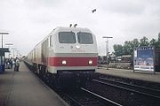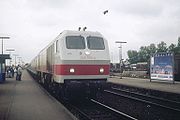
DB Class 240
Encyclopedia
The DB Class 240 are a class of Co'Co' diesel electric locomotives which were produced in the 1980s by MaK
in collaboration with Krupp
and ABB as DE 1024 as prototypes/technology demonstrators for a possible future order from the Deutsche Bundesbahn
.
Three units were made, but no orders arose, at least in part to the Reunification of Germany making similarly specified DR Class 132s available in large numbers.
 In the late 1980s MaK built, at the companies own expense, three new prototypes were built, designated as the DE 1024. They were designed as a universal high powered locomotive, capable of hauling both freight and passenger trains, for use on the non-electrified parts of the German rail network - which at that time included much of northern Germany. In October 1989 the machines were ready for use, and extensive testing took, with the units being passed to DB for assessment. No orders from the Deutsche Bundesbahn came as a result of this - instead electrification of parts of the northern German rail network took place, the reunification of Germany put a nail in the coffin of the possibility of any orders from the home country; as large numbers of similar DR Class 132 locomotives became available.
In the late 1980s MaK built, at the companies own expense, three new prototypes were built, designated as the DE 1024. They were designed as a universal high powered locomotive, capable of hauling both freight and passenger trains, for use on the non-electrified parts of the German rail network - which at that time included much of northern Germany. In October 1989 the machines were ready for use, and extensive testing took, with the units being passed to DB for assessment. No orders from the Deutsche Bundesbahn came as a result of this - instead electrification of parts of the northern German rail network took place, the reunification of Germany put a nail in the coffin of the possibility of any orders from the home country; as large numbers of similar DR Class 132 locomotives became available.
In keeping with their northern German birth and operations the locomotives were named "Kiel", "Westerland" and "Lübeck" respectively.
by MaK (and at the time the largest single engined diesel in Germany), the locomotives used an electrical power transmission system supplied by ABB with microprocessor control and GTO
power electronics. In common with other MaK locomotives of that time (e.g. MaK G1206) the internal design was based around the idea of modular construction, with individual parts (engine, traction electronics etc) being easily replaceable, and interchangeable with alternative units.
The engine was a twelve cylinder MaK 12M282, with a power of at which drove an alternator (type WB630K8) producing 3 phase AC at a maximum voltage of . This electrical supply is then rectified to provide DC power to switching electronics controlled by a microprocessor, which in turn provide the electrical power supply for three phase asynchronous traction motors (of type 6FRA3368). Additional electrical supply of up to 700 kW could be provided for electrical train heating
etc.
The three units were leased via Traffic Krupp GmbH whilst MaK was under Krupp ownership, being on hire to DBAG
in the early 1990s. In 1994 MaK changed hands - becoming part of Siemens
as Siemens Schienenfahrzeugtechnik, the locomotives were withdrawn from DB service in 1996, and were subsequently leased to Häfen und Güterverkehr Köln (HGK) and given the numbers EN 11, 12 and 13.
The first unit suffered a fire in one of the bogies in 2008, writing the locomotive off.
The second unit was damaged by an unexplained cab fire in 2005 . It was however repaired between July 2009 and September 2010 by Voith
Turbo, which rebuilt the locomotive as an dual power source electro-diesel locomotive
. This locomotive will serve as a proof of concept
for the CREAM-project, funded by the European Commission. The concept locomotive was baptised Voith Futura.
, both for the inclusion of an electronically controlled power system, and the modular design plan.
Since only one locomotive remains in service, with no further machines expected the final example has an element of cult status amongst some diesel-electric train fans.
Mak
Mak is a Chinese surname. It is commonly transliterated as Mak in Hong Kong, based on the Cantonese pronunciation of the Chinese character; and is commonly transliterated as Mai in China, based on the Mandarin pronunciation. Other transliterations of the surname include Mack, Mark, Mac, and Mach...
in collaboration with Krupp
Krupp
The Krupp family , a prominent 400-year-old German dynasty from Essen, have become famous for their steel production and for their manufacture of ammunition and armaments. The family business, known as Friedrich Krupp AG Hoesch-Krupp, was the largest company in Europe at the beginning of the 20th...
and ABB as DE 1024 as prototypes/technology demonstrators for a possible future order from the Deutsche Bundesbahn
Deutsche Bundesbahn
The Deutsche Bundesbahn or DB was formed as the state railway of the newly established Federal Republic of Germany on September 7, 1949 as a successor of the Deutsche Reichsbahn-Gesellschaft '...
.
Three units were made, but no orders arose, at least in part to the Reunification of Germany making similarly specified DR Class 132s available in large numbers.
History and Background

In keeping with their northern German birth and operations the locomotives were named "Kiel", "Westerland" and "Lübeck" respectively.
Design
Assembled at KielKiel
Kiel is the capital and most populous city in the northern German state of Schleswig-Holstein, with a population of 238,049 .Kiel is approximately north of Hamburg. Due to its geographic location in the north of Germany, the southeast of the Jutland peninsula, and the southwestern shore of the...
by MaK (and at the time the largest single engined diesel in Germany), the locomotives used an electrical power transmission system supplied by ABB with microprocessor control and GTO
Gate turn-off thyristor
A gate turn-off thyristor is a special type of thyristor, a high-power semiconductor device. GTOs, as opposed to normal thyristors, are fully controllable switches which can be turned on and off by their third lead, the GATE lead.-Device description:...
power electronics. In common with other MaK locomotives of that time (e.g. MaK G1206) the internal design was based around the idea of modular construction, with individual parts (engine, traction electronics etc) being easily replaceable, and interchangeable with alternative units.
The engine was a twelve cylinder MaK 12M282, with a power of at which drove an alternator (type WB630K8) producing 3 phase AC at a maximum voltage of . This electrical supply is then rectified to provide DC power to switching electronics controlled by a microprocessor, which in turn provide the electrical power supply for three phase asynchronous traction motors (of type 6FRA3368). Additional electrical supply of up to 700 kW could be provided for electrical train heating
Head end power
Head end power or electric train supply is a rail transport term for the electrical power distribution system on a passenger train. The power source, usually a locomotive at the front or “head” of a train or a generator car, generates all the electricity used for lighting, electrical and other...
etc.
Operations
After testing and the trial runs with DB the locomotives returned to MaK.The three units were leased via Traffic Krupp GmbH whilst MaK was under Krupp ownership, being on hire to DBAG
Deutsche Bahn
Deutsche Bahn AG is the German national railway company, a private joint stock company . Headquartered in Berlin, it came into existence in 1994 as the successor to the former state railways of Germany, the Deutsche Bundesbahn of West Germany and the Deutsche Reichsbahn of East Germany...
in the early 1990s. In 1994 MaK changed hands - becoming part of Siemens
Siemens
Siemens may refer toSiemens, a German family name carried by generations of telecommunications industrialists, including:* Werner von Siemens , inventor, founder of Siemens AG...
as Siemens Schienenfahrzeugtechnik, the locomotives were withdrawn from DB service in 1996, and were subsequently leased to Häfen und Güterverkehr Köln (HGK) and given the numbers EN 11, 12 and 13.
The first unit suffered a fire in one of the bogies in 2008, writing the locomotive off.
The second unit was damaged by an unexplained cab fire in 2005 . It was however repaired between July 2009 and September 2010 by Voith
Voith
The Voith GmbH, which is headquartered in Germany, is a family-run corporation in the mechanical engineering sector with worldwide operations....
Turbo, which rebuilt the locomotive as an dual power source electro-diesel locomotive
Electro-diesel locomotive
An Electro-diesel locomotive is powered either from an electricity supply or by using the onboard diesel engine...
. This locomotive will serve as a proof of concept
Proof of concept
A proof of concept or a proof of principle is a realization of a certain method or idea to demonstrate its feasibility, or a demonstration in principle, whose purpose is to verify that some concept or theory that has the potential of being used...
for the CREAM-project, funded by the European Commission. The concept locomotive was baptised Voith Futura.
Conclusions
The concept and design of these locomotives served as the basis for the NSB Di6 class, which have received negative headlines due to their rejection and return from the Norwegian railways. The locomotives can be considered forerunners of the modern diesel electric locomotives of the 2000s such as the EurorunnerEurorunner
The Eurorunner family of locomotives are a series of medium to high power diesel electric locomotives built by Siemens for the European market. Introduced from 2002 onwards, they share design characteristics with the successful Eurosprinter range of electric locomotives, also built by Siemens.The...
, both for the inclusion of an electronically controlled power system, and the modular design plan.
Since only one locomotive remains in service, with no further machines expected the final example has an element of cult status amongst some diesel-electric train fans.
Sources
- DE 1024 loks-aus-kiel.de : Fleet history, technical specifications.
- Dieselelektrische Hochleistungslokomotive Baureihe 240 leo.org : Technical details and testing information
- BR 240 MaK-Diesselok DE 1024 bahntantchen.de : History, naming, and photo gallery.
- HGK Loks, MaK DE 1024, railrunner.de : History, technical, numbering, and schematic technical drawings.

